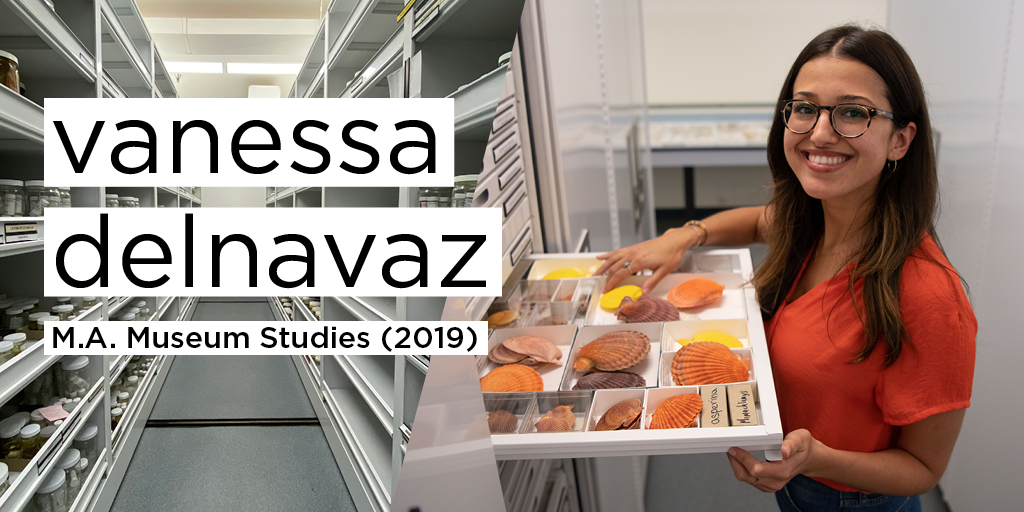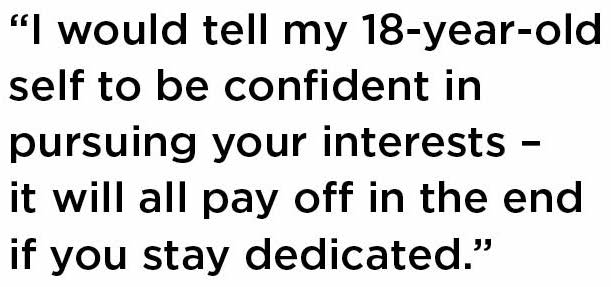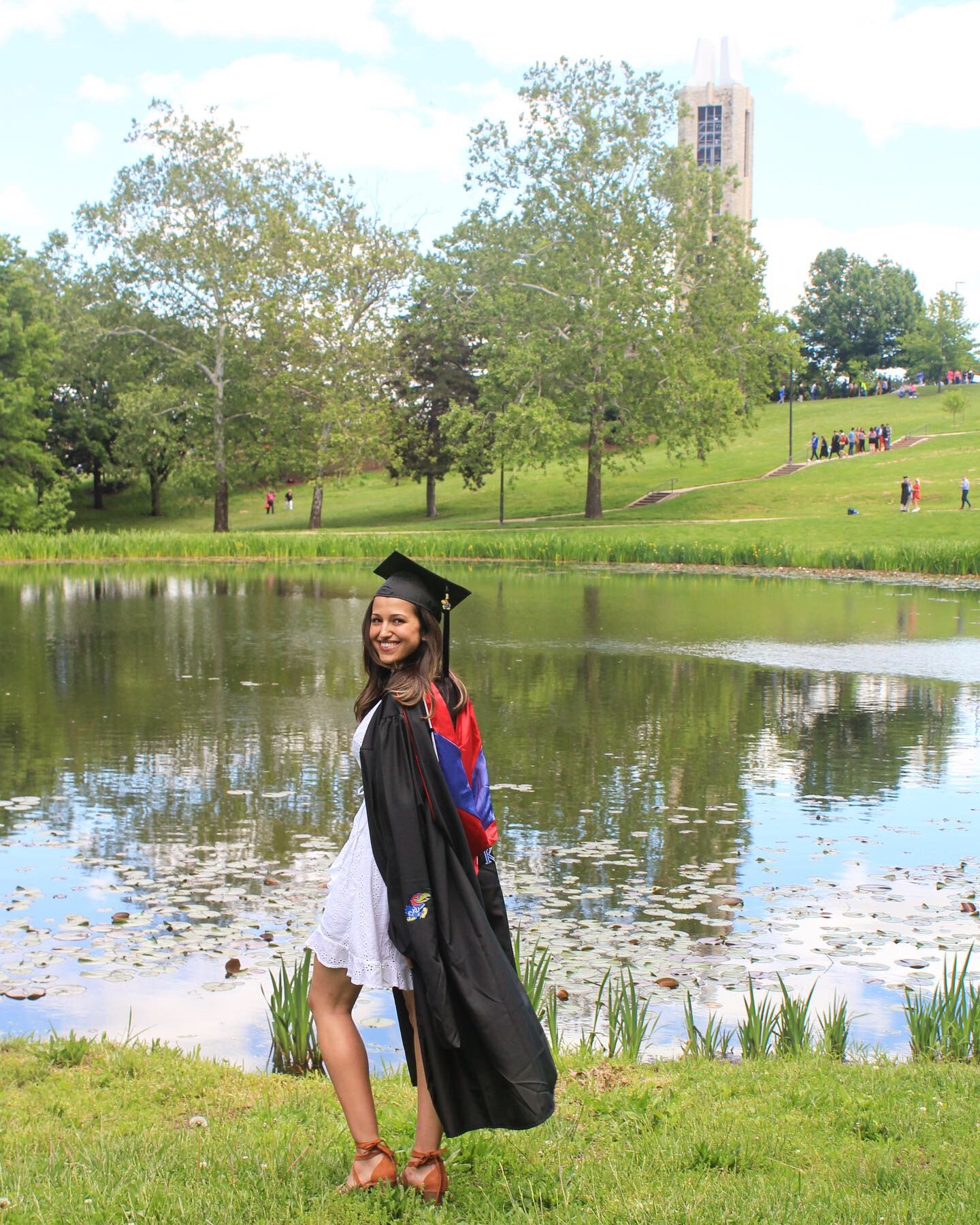
Why Vanessa’s a Hawk to Watch:
Behind every life, there’s a story. The same could also be said of every species — and indeed, every specimen. And the Santa Barbara Museum of Natural History has a lot of stories to tell. Millions of them, in fact.
There, Vanessa Delnavaz and her team are untangling evolutionary relationships and revealing connections between organisms to provide a space for curious minds to come together to better understand life on Earth — in all its complex, diverse, beautiful forms.
As the manager of the museum’s Invertebrate Zoology Collection, Vanessa melds her love for marine biology and passion for museums daily by identifying, documenting and preserving the diversity of life for future generations. Composed of 2.5 million specimens, the vast collection is home to sea-dwelling creatures including clams, snails, crabs and worms.
A lifelong science enthusiast, Vanessa’s eyes were opened to the possibilities of a career in museums after a summer trip to the Smithsonian, where she discovered the field’s unique role in making research accessible to broad audiences — a discovery that would eventually put her on a path to KU’s Museum Studies program and hands-on work in the Biodiversity Institute. Now back in her home state of California, she’s living her out dreams in an always-busy (but never uninteresting) role that, depending on the day, might include public engagement, lab work or hours of painstaking seashell analysis.
With species spanning all sizes, natural habitats and geographies, attempting to bring order to the planet’s wildly diverse invertebrate populations can seem like a daunting task. But for Vanessa, any contribution made in the name of improving public access to the “library of life,” as she calls it, is well worth the effort.
Tell us in a sentence or two what you do for a living:
I manage the Invertebrate Zoology Collection at the Santa Barbara Museum of Natural History, which contains 2.5 million scientific specimens.

How did you end up doing what you do?
During my time working towards a bachelor’s degree in Marine Biology at the University of California, Santa Cruz, I had gained a lot of experience working in research labs and out in the field, but I still didn’t know exactly what I wanted out of a career. What I did know was that I loved science and nature, but wasn’t sure what I wanted to do with that passion. The summer after I graduated, my family took a trip to Washington, D.C., where I visited the Smithsonian Museum of Natural History for the first time. Seeing everything I loved about natural history all under one roof, for all to visit, resonated with me. There, I realized that museums encapsulate science in a way that can be accessible to everyone. It was then that I decided I wanted to pursue a career in the museum field.

Back at home, I soon started volunteering in the collections at the Natural History Museum of Los Angeles County. This is where I fell in love with the collections aspect of natural history museums in particular – where evidence of the diversity of life is researched and preserved for generations to come. A ‘library of life’, I like to call it. After about a year, I applied and started in a part-time, temporary position as a butterfly pavilion attendant at the Santa Barbara Museum of Natural History. Once there, I also began volunteering in their Invertebrate Zoology collection. The butterfly position eventually ended, and I was hired on as a curatorial assistant in the collections at SBMNH. During this time was when I decided I wanted to go back to school for a masters in museum studies, and applied to the University of Kansas. After two amazing years in the KU Museum Studies Program, I was lucky enough to return to the Santa Barbara Museum of Natural History to fill the roll of Invertebrate Zoology Collection Manager.

What’s your favorite part about your current job? What does an average day or week look like in your role?
My favorite part about my job is that I get to combine my love for marine biology and museums every single day. Most of my time is spent doing work related to the specimens in the collection, whether that is identifying what they are, cataloging them into our database, or making sure our data is accessible to researchers and educators around the world. In addition to collection work, I also have the opportunity to engage in education and outreach activities, which is always very fulfilling to me. Some days I’m holed up in my office looking at seashells for hours on end, and others I’m engaging with the museum public. Each day is always different, which keeps things exciting.
What do you feel is your biggest achievement so far?
In January 2021, I organized and hosted a virtual conference for the annual Southern California Unified Malacologists meeting. (Malacologists are people who study mollusks – think clams, snails, octopus and squid). We had 61 attendees, and because it was virtual, we were able to have people join in from other regions outside of Southern California, including a number of attendees from other countries. It was rewarding to be able to organize such an event in the middle of a pandemic, as well as have it be more accessible to a greater audience than in years past.

What do you know now that you wish you could tell your 18-year-old self?
I would tell my 18-year-old self to be confident in pursuing your interests – it will all pay off in the end if you stay dedicated. Don’t listen to people who are telling you to stray away from an education or career that is not traditionally seen as one that is considered ‘successful’. Success should be determined in some large part by how happy you are with what you do in your life, not just your status or the amount of money you earn.
What’s your lowest career moment and how did you pick yourself up and move on?
Working remotely during the COVID-19 pandemic is rough when so much of the job is tied to hands-on work with physical things. I was lucky to be able to have access to the collection for much of the lock-down, but it made it hard to get productive work done. We had to be innovative and creative in the way we did our remote work. We shifted to cataloging specimens from ledgers that had been scanned rather than from the labels that are housed with the specimens, and also worked on data clean-up in our database.


Where do you hope to be in 10 years?
I actually hope to still be in my same position; it truly is my dream job. However, I know it is also important to always strive for new opportunities and growth. In conjunction with my work as a collection manager, I would love to one day teach a museum studies or natural history collections course at a local community college.
How did your KU degree prepare you for your current job? What opportunities should current students take advantage of while at KU?
I gained an incredible amount of hands-on experience at the University of Kansas Biodiversity Institute. I was able to apply everything I was learning in my classes in real-time, at one of the best college-based natural history museums in the country. Current students should take advantage of the spectacular museums that are on the KU campus. These include the Spencer Museum of Art, the Natural History Museum, Robert J. Dole Institute of Politics, and the Booth Family Hall of Athletics. Visit them, they are free for students! They offer a wealth of information about the surrounding community, wildlife, and KU history.

What’s your best career pro-tip?
Work collaboratively with everyone in your institution (or organization, or company). It will help you learn about the institution as a whole, and you will become familiar with aspects that you are not so actively involved in, but are still a major component of the overall mission. This is especially important in museums, where scientists, education, outreach, and the public all come together in one space.
What do you do after you’ve clocked out?
My favorite off-the-clock activities include exploring tidepools, baking, reading, and knitting. Since moving to Santa Barbara, I’ve also been learning how to surf, which has been a life-long dream of mine.
What is a fun fact about you that surprises people?
Although much of my museum experience, past and current, is focused on marine invertebrates, much of my time in college was spent working with marine mammals. I’ve spent 3 months on an uninhabited island to help study the behavior of northern elephant seals, as well as spent time in Australia helping with a study focused on humpback whale behavior and vocalizations.
Meet more of our Hawks to Watch. For more information, visit the Museum Studies Program at the University of Kansas. Explore the Santa Barbara Museum of Natural History.
Photos courtesy of the Santa Barbara Museum of Natural History.
Hawks to Watch are disrupters. They’re poised for greatness, inspiring their colleagues and excelling in their professions. Basically, they’re killing it. Having recently graduated, they are just starting to leave their mark and we can’t wait to see how their story unfolds. These Jayhawks span all industries including business, non-profits, tech, healthcare, media, law and the arts.